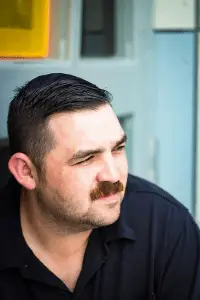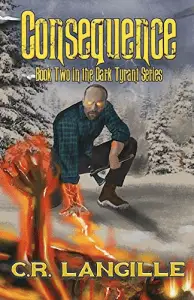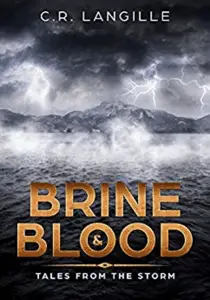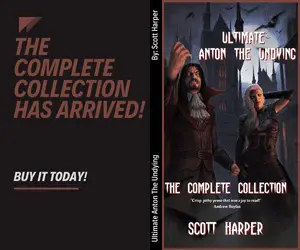The Horror Tree Presents…An Interview with C.R. Langille

 Claire: Hi C.R.! How are you? What have you been up to on the writing front?
Claire: Hi C.R.! How are you? What have you been up to on the writing front?
C.R.: I’m great! Thank you for asking. At the moment I’m working on an episodic shared-world serial set in a grim, post-apocalyptic fantasy world where all the gods have died. Think if Cormac McCarthy’s The Road had a bastard child with Martin’s Song of Ice and Fire…maybe a pinch of Robert E. Howard in there for taste. I’ve also been finishing up the first draft of the third book in my Dark Tyrant Series.
Claire: Tell me about you! Are you a full-time writer, or do you work in ‘the real world’?
C.R.: I work in the real world as you put it. I’ve been in the military for nearly 20 years now. I’m actually set to retire in September, where I plan on writing full-time. It’s been a challenge trying to juggle writing, work, and family. I’m okay at that juggle. However, I know of a lot of folks who are masters at making it work. It amazes me what people are capable of if they put their mind to something.

Canyon Shadows
C.R.: Consequence and Canyon Shadows are dark urban fantasy books with some heavy horror elements. However, all that aside, the stories are really about how much someone is willing to sacrifice for their loved ones.
They are both set in Utah, my home state. Canyon Shadows deals with a small town I created in Southern Utah of the same name, where an ancient entity known as the Dark Tyrant was imprisoned deep in the mountain when the earth was still young. As time has worn on, the Tyrant has grown stronger and he seeks a way free from his bonds. Consequence, takes place right after the Tyrant has broken free and a demonic apocalypse kicks off across the world.
 When I started off to write these books, they were going to be traditional horror novels; however, as I fleshed out the stories, I couldn’t help but add elements of magic and other strange things. I think it stemmed from my love of reading fantasy novels when I was younger. I started really getting into reading with Dragonlance and Forgotten Realms books, my absolute favourite still being Homeland by R.A. Salvatore.
When I started off to write these books, they were going to be traditional horror novels; however, as I fleshed out the stories, I couldn’t help but add elements of magic and other strange things. I think it stemmed from my love of reading fantasy novels when I was younger. I started really getting into reading with Dragonlance and Forgotten Realms books, my absolute favourite still being Homeland by R.A. Salvatore.
I finally embraced it and my books turned into this mix of urban fantasy and horror which I think is really fun. I have a certain scene in Consequence that I’ve been told was traumatizing to a reader.
Claire: As well as being published in magazines, you also self-publish. What do you enjoy about self-publishing?
C.R.: I enjoy the freedom that comes with self-publishing. I set my own deadlines, goals, and objectives. I like being able to release on my own schedule as well. The best part, is all the return comes to me and I’m not sharing any of that royalty with a publishing house. However, don’t get me wrong, there are certainly drawbacks to self-publishing as well. For example, all the cost is now on me (cover art, ISBNs, editing, interior design, etc), not to mention all the marketing is up to me as well. I’ve had to become educated on marketing and I’ve only scratched the surface.
Claire: Tell me about your writing process. Do you set aside time to write, or do you write as your stories come to you?
C.R.: At the moment I try and sneak in writing whenever I can. My schedule is pretty crazy at the moment. I know there are a lot of successful folks who get up super early in the morning and do all their things…well, that isn’t me. I think if I tried to do something like that there would be an incident. As for plotting books, I gave that up a long time ago. It doesn’t work for me. I’d spend all this time and energy plotting out each chapter, and it would derail by the middle of chapter one. The way I do it, is I know the major scenes and the end, so I know where I’m headed, and then I’ll just ensure I write what I need to end up at those scenes.
Claire: I see you also write for younger readers. Is your writing process different for younger readers than it is for adults?
C.R.: Very much so! My stories for adults are way darker than anything I’d ever write for young readers. I have to be careful when I’m writing those stories that they don’t get too scary or bleak. That doesn’t mean I don’t write scary stories for young readers, because I do. I grew up watching scary movies and loving horror from a very young age, and I think it’s important that kids and teens experience those emotions in a healthy way.
Claire: How long have you been writing for?
C.R.: I started writing over 20 years ago for fun, but I decided to get serious about writing 17 years ago.
Claire: You have a MFA: Writing Popular Fiction from Seton Hill University. How has that impacted your writing career?
C.R.: Getting my MFA from Seton Hill was one of the smartest things I ever did for my writing career. My first published short story came out in October of 2011 and as you could imagine, I was excited about it. When I was accepted at Seton Hill I thought I knew a lot about writing, turns out I was wrong. I realized pretty quickly that I had a lot more to learn. They also taught at a lot of the back-end pieces of writing like market study, research, querying agents, teaching, etc… The greatest thing about Seton Hill’s program though, wasn’t just the education, but the networking. I met so many awesome people out there that I still converse with today.
Claire: I see you’re a tabletop gamer. Does that help shape your writing?
C.R.: Definitely! I started playing paper/pencil RPG’s when I was in 6th grade. None of my friends at the time had ever played, so it was on me to get the books, learn how to play, teach them, and ultimately run the games. I spent a lot of my formative years creating adventures, campaigns, monsters, and characters for them to enjoy. I still run games today as the DM/GM. There is no doubt in my mind that being able to create fun adventures for people and see how they unfold has helped me with creating stories for folks to read.
Claire. Reading through your blog, I see you’re also an expert in survival techniques, and regularly post about your activities. Does that aspect of your life influence your writing? If so, how?
C.R.: Indeed it does. The Air Force sent me to an outdoor survival school which was amazing and throughout the years I’ve taken other classes and seminars to help reinforce those skills. Whenever I’m writing about a character that is stuck in the wilderness, I pull on that knowledge to help me create realistic scenes. In fact, the main character in Consequence has some of the same training and utilizes his training as he’s fighting his way through the forest.
Claire: You also mention you’re inspired by the Utah outdoors. How do you blend real locations within your stories?
C.R.: I like to draw on real experience in my books. I think it’s that touch of reality that helps turn horror even scarier. There are places both Canyon Shadows and Consequence that are very real. A lot of the times if I come across something unique, or something that sticks out to me, I’ll make a note and incorporate it somehow later. For example, in Canyon Shadows, there is a scene where the character is driving along a lonely road on his way to Canyon Shadows, Utah. Canyon Shadows itself is a fictional place; however, along the way he passes a run-down cabin in the middle of a field. I first saw that cabin when I was a very young boy and always wondered who built it, what its story was, and how long it had been there.
 The coolest thing, is that I give enough information in the book, that anyone can go find that place and experience the same things as well. The hunting scene in Consequence is drawn from an area I hunted several years ago. Black Rock in “Brine and Blood” is a real landmark near the Great Salt Lake. The list goes on, but I think adding a touch of realism enhances the story.
The coolest thing, is that I give enough information in the book, that anyone can go find that place and experience the same things as well. The hunting scene in Consequence is drawn from an area I hunted several years ago. Black Rock in “Brine and Blood” is a real landmark near the Great Salt Lake. The list goes on, but I think adding a touch of realism enhances the story.
Claire: You’re a member of the Horror Writer’s Association. What does being a member mean to you? How has it furthered your writing career?
C.R.: For me, being a member of the HWA is a way of showing that one, I take my writing seriously. I love horror and writing and the HWA promotes both of those things. It’s a great way to network as well and bounce ideas off other like-minded individuals. I like to give back as well, and I’ve participated in the HWA’s mentorship program for the past few years. Basically they will pair up a newer mentor or someone who wants help with their writing, with another HWA member who has some experience. I enjoy being involved in the mentoring program, because just like any good mentoring relationship, if done right both participants can learn a great deal from one another.
Claire: Tell me about your protagonists. Do you base them on people you know? Or are they purely fictitious?
C.R.: My protagonists are mainly fictitious; however, I do incorporate some aspects of real people at times. Not just with my protagonists, but with supporting characters as well. When I’m out and about, or interacting with folks, I am always taking note of interesting mannerisms. During my studies at Seton Hill one of the teachers mentioned people watching as a research skill. Basically, take a notepad and go sit in a coffee shop, or a store or shopping mall and just watch people. You’d be amazed at the amount of interesting things that come from that.
Claire. I see you also review movies. What do you enjoy about reviewing?
C.R.: Reviewing is a way for me to unpack what I just watched. It’s a way for me to analyse my own thoughts on what happened. What worked and what didn’t. Mainly, I love hearing back from people to see if my own views line up with what they were thinking or seeing if I’m way off. I generally only review movies or books that made an impression, so it’s another way for folks to see what influences me as a writer and a person.
Claire: What’s your favourite book?
C.R.: That’s a tough one. My taste in books have changed so much over the years it’s hard to pin down. Some books that have influenced me or left an impression throughout the years are Homeland by R.A. Salvatore, The Shining by Stephen King, and Penpal by Dathan Auerbach.
Claire: You’re stuck on a desert island. Being a survivalist, what would you do?
C.R.: I’m going to stick with the basics and follow a few simple things. Let’s talk about the rule of threes to begin with. This is an over-generalization because extremes can definitely change the timelines, but a person can last three hours exposed in harsh climates, three days without water, and thirty days without food. Therefore, my first priority is going to be finding or making shelter. I am assuming if it is a desert island that heat is going to be the biggest factor, so shade and protection from rain/storms. Depending on what’s around me that shelter could be a debris shelter, a lean-to, or even a cave if such a thing exists. Things I’d be looking for is a location that is close to a water source, fuel for a fire, and food (if all that is possible).
Following that, my next priority is going to be water. Ideally, there is a body of fresh water on this island, which would make things easier. At that point I just need to figure out a method of purification which probably means building a fire.
After fire and water is taken care of, I would need to find food. I’d be looking at local wildlife, insects, and plants to cover that aspect.
Finally, after all of that, I’d be looking for a means of rescue. That means building SOS signs large enough to be seen from the air. Having three large bonfires ready to go at a moment’s notice to signal I need help, or things of that nature.
Of course, all of this is easier said than done and it comes down to having the skills to implement this type of training, and ultimately having the will to live in a survival situation. Nothing is guaranteed, but proper training and the will to live can go a long ways to successfully surviving in an extreme environment.
Claire, I want to thank you for taking the time to interview me. It’s been a lot of fun and I appreciate the opportunity.










